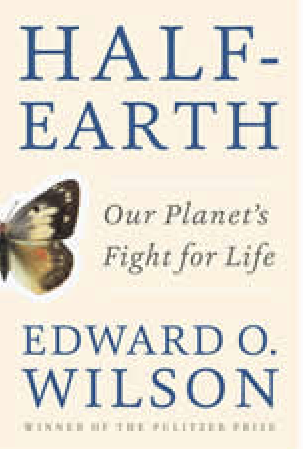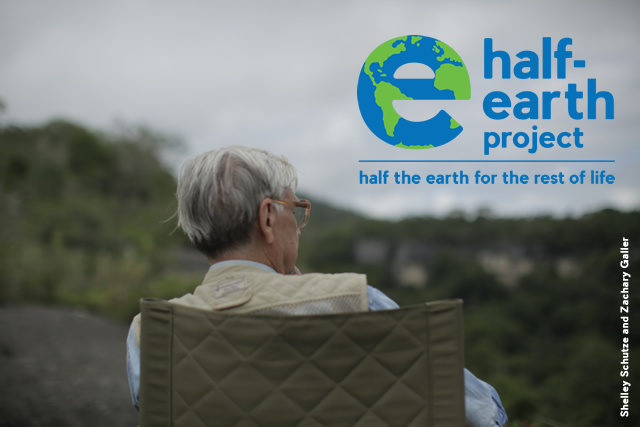“Half-Earth: Our Planet’s Fight for Life by Edward O. Wilson – Review”
By Robin McKie
Originally published in The Guardian, April 11, 2016
In 2000, workers finished construction of a hydropower plant in Tanzania’s Udzungwa mountains. A giant reservoir was created by damming 90% of the water that had previously poured into nearby Kihansi gorge. The consequences for indigenous species were disastrous, in particular for the tiny, golden-hued Kihansi spray toad. The little amphibian once thrived, in its thousands, in a single two-hectare patch of forest watered with spray from the gorge’s falls. Those waters dried up, as did the little homeland of the toad, which became extinct in the wild within a couple of years. Thus the end product of a million years of evolution was removed from nature by a single act of thoughtless habitat intrusion.


For Edward O Wilson, the spray toad’s fate perfectly encapsulates a biological crisis that now hangs over the Earth, a global endgame that threatens to eradicate virtually all our wild animals and plants. Among the many other victims outlined in this deeply disturbing work are the yellow-blossom mussel, the plateau chub, the mammoth, the passenger pigeon, the stirrup shell, the Tasmanian tiger, the dodo, the ivory-billed woodpecker and the baiji dolphin. However, the fate of the Kihansi spray toad touches Wilson most of all.
“The plight of the little animal should all by itself serve as a wake-up call to us for mass extinctions imminent or in progress round the world,” he states. “We’re extinguishing Earth’s biodiversity as though the species of the natural world are no better than weeds and kitchen vermin. Have we no shame?”
The answer, of course, is a straightforward no. For the most part, we don’t give a damn. The activities of Homo sapiens – “a lucky accident of primate evolution”, as Wilson describes us – have made us the most destructive but unrepentant species in Earth’s history. When not constructing dams, we build farms, holiday resorts and factories that obliterate precious habitats and by using the atmosphere as the carbon dump of the Industrial Revolution we are transforming Earth’s climate system into a hothouse. To these ecological crimes we can add global pollution, unrestrained population growth and overhunting. The result? A thousandfold increase in species extinction rates since modern humans first appeared in Africa more than 100,000 years ago.
“We’re extinguishing Earth’s biodiversity as though species are no better than weeds and kitchen vermin.”
—Edward O Wilson
So intense has been our impact on the planet that most scientists, Wilson included, believe we have now entered a new epoch, one defined not by natural influences but by those let loose by human beings. This is the Anthropocene, which is delineated by the way we are now altering habitats, the climate and even the earth beneath our feet. “We thrash about, appallingly led, with no particular goal other than economic growth and unfettered consumption,” says Wilson. In the meantime, nature withers and dies.
What really concerns Wilson, however, is what is likely to follow. As the Anthropocene grinds on, humanity will continue to wipe out wildlife and plants. Earth will end up being inhabited by people, domesticated plants and animals, croplands as far as the eye can see – and little else except for some fungi, microbes and jellyfish. We will then have entered the next Earthly epoch: the Eremocine, the Age of Loneliness.
We should note that in wiping out species at a rate that far outstrips our ability to understand or study them, humanity leaves itself seriously compromised. Consider the problem of invasive species that are a danger to agriculture. One day a new type of fruit fly will appear in our fields and threaten our crops and orchards. A first line of response would be to look at this invader’s natural enemies in order to ally them to our cause. But in the near future, we may well find that by then we have eradicated them, thus seriously compromising our ability to fight off the new invaders.
Then there is the moral issue. For centuries, we have been obliterating species for the most trivial of reasons, with the rhinoceros providing a particularly chilling example. Millions of these great animals once thundered over African plains or slipped silently through Asian rain forests. Today the rhino has been driven close to extinction because its horn is valued as a traditional medicine when, in fact, it is as effective as a healing agent as a human fingernail.
So what should be done? For Wilson, there is only one solution. We must increase the land we have set aside for reserves for protecting wild plants and animals until this terrain covers half the globe. Such a project would then give us a reasonable chance of saving around 80% of species still alive today, he argues.
It is an audacious idea. But given the identity of its proposer – Wilson is one of the world’s greatest naturalists and a double Pulitzer prize winner – it is one that should surely be taken seriously. And given that habitats protected by governments and agencies already account for 15% of Earth’s land area, according to Wilson, it could be argued that we have at least made some kind of start.
Unfortunately, having prepared his case so carefully, Wilson then stops in his tracks and hesitates, providing no detail of the measures needed to ensure his goal is completed or any indication of how we can expand nature reserves so they reach the Half-Earth status he craves. Nor does he offer any inkling of what territories should be annexed or what funding mechanisms or agreements will be required to achieve his goal. This is a pretty serious limitation. Earth’s population is set to rise from 7 to nearly 10 billion people by 2050, so pressure on existing wild territory is destined to rise even further. Yet Wilson seems to think this is no real impediment. His rhetoric soars but practical propositions in Half-Earth are as thin on the ground as spray toads in the Kihansi rainforest.
A book that was a little more prescriptive would certainly have been welcome. This is not say that Half-Earth is a washout. As an outline of our terrible ecological plight, it does a first-class job. Wilson is, if nothing else, a gifted wordsmith and Half-Earth is a much-needed antidote to the views of those who assert that our worldly woes are exaggerated and that everything is tickety-boo in the Garden of Eden. As he points out, such believers tend to have the least personal experience of the planet, a point once emphasised by the explorer-naturalist Alexander von Humboldt: “The most dangerous worldview is the worldview of those have not viewed the world.” Wilson has certainly viewed the world and seen its wildlife close up and personal. We should at least listen to his warning.
Related: More coverage of Half-Earth



